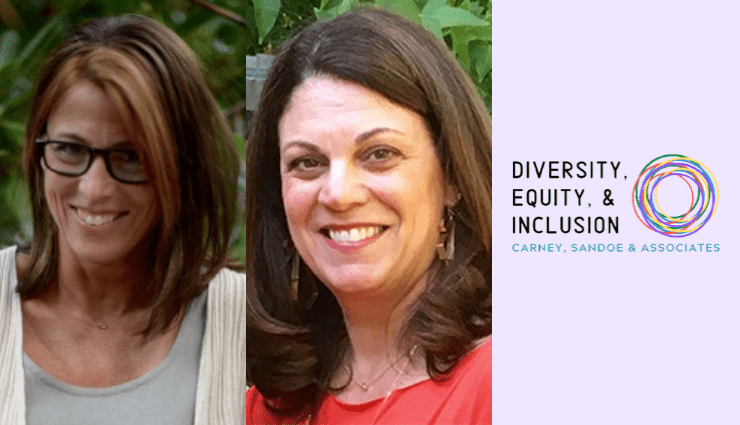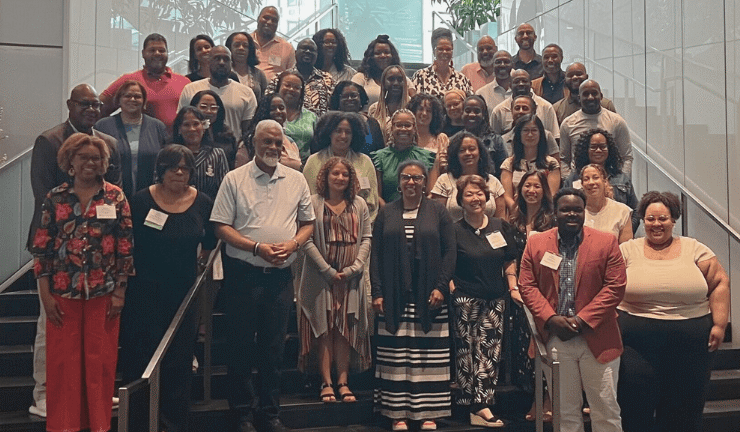White Fragility in Students

This is a piece from CS&A’s winter focus on diversity, equity, and inclusion in schools. Read more from this series here.
Join us at FORUM/Diversity, a two-day combined faculty recruitment and DEI professional development event on January 31 and February 1 in Philadelphia.
In our interviews with young people around the country for our Teaching While White podcast, we have seen firsthand an inability among white students to talk about race without exhibiting racial stress. We hear white children as young as nine years old express anxiety about being white and what they think that means. Often white students, who mind you have volunteered to be interviewed, feel ill equipped and sometimes unable to engage in racial conversations. It seems that we are successfully raising the next generation of white people who will continue to feel afraid and reluctant to talk about race.
There is a common cultural myth that racism is diminishing among youth today. Not only are white students not talking about race, but incidents of blatant individual acts of racism are currently on the rise. According to the Southern Poverty Law Center (SPLC), there has been a surge in reports of hate and bias in schools in the last three years. Racism appears to be the motivation behind a high percentage of these hate and bias incidents, accounting for 63% of incidents reported in the news and 33% of incidents reported by teachers in the SPLC survey. School responses to this uptick in racialized incidents has been disappointing. More than two-thirds of the educators SPLC surveyed had witnessed a hate or bias incident in their school. According to the report, “most of the hate and bias incidents witnessed by educators were not addressed by school leaders. No one was disciplined in 57% of them. Nine times out of 10, administrators failed to denounce the bias or to reaffirm school values.”
When we do not give language to and discuss race, we leave students, and in particular white students who are often not discussing race at home, open to create their own meaning making out of the heavily racialized world they see and experience. I myself (Jenna) attended one of the last schools to desegregate in the country in Charlottesville, Virginia, and though many of the students were black, almost all of the teachers and administrators were white. I can recall with vivid clarity many of the daily racial incidents that took place, and yet to talk about race, I was led to believe, was to be racist. So even though my family members considered themselves good, white liberals who cared about racial equity, no one discussed with me the racialized mess I witnessed and participated in every day. Sadly, it made sense to me at the time that black students were disciplined more often than white students — they were louder and more unruly. Their parents either didn’t care about education or were absent. Without any framework for understanding racial history, myths, stereotypes, and flat-out lies about people of color, I had to create my own understanding of what I thought I saw.
What alarms us more is that we continue to see children and educators doing the same thing. The lack of discussion and understanding of race supports extremely harmful myths about intellect, ability, and even humanity being racially superior or inferior. We continually hear white students attribute their success entirely to their own efforts. We continue to hear discussions about race-based achievement gaps without any analysis of how teacher expectations, racial stress, and systems are failing students. There is still little discussion about opportunity gaps or the ways that racial bias impacts teacher expectations, which is the most consistent predictor of academic success.
A recent study by Sesame Workshop and the University of Chicago found that although parents say they are comfortable talking about issues of race, the majority of white parents are rarely, if ever, having conversations with their children about racial topics. Not surprisingly, parents of color are more likely to discuss race with their children. Yet, even when parents do talk about racial identity, many wait until their children are 10 years old or older. So, if parents are not teaching their children about race in a thoughtful manner, our larger culture is more than ready to fill in the gaps in ways that are not helpful. As a result, children end up seeing difference as some kind of deficit and are left to make up their own explanation for what they see. More troubling, most parents only talk about racial identity if their children have heard something negative about their own identity. This partly explains why more parents of color than white parents are having these conversations with their children. White parents are able to avoid racial topics because their children are far less likely to come under threat because of their racial identity.
The role of educators in conversations about race becomes even more important given that the first time many children will talk about their racial identity may be at school.
Yet, if the only time race is mentioned in school is when we are talking about oppression — slavery, internment camps, the civil rights movement, etc. — children of color only see their identity represented in a negative context, and white children are left with only racist portrayals of white people. This leaves white students vulnerable to the messages of white supremacists groups that are actively recruiting white students and white boys in particular, offering the comfort of slogans such as, “It’s OK to be White!”
All students need to be able to discuss racial issues with a healthy understanding of the history and complexity of systemic racism — to know that it is not about “good” or “bad” white people, and not about individual acts of discrimination. As Ali Michael says in her Ted Talk, a healthy white racial identity is not about feeling bad about being white. It is also not about feeling good about being white. It is about understanding that whiteness is not peripheral to who we are. We need our students to understand that race is integral to who we are as white people, not just something people of color have.
When white people have a negative racial identity, it prevents them from being able to identify and analyze the many pervasive myths and stereotypes about race. They cannot see the structures that give unearned advantage to white people and systematically create obstacles for people of color. This system is taken for granted, deeply embedded in our institutions and often believed to be based in meritocracy. It is a delusional understanding of the world, and through inaction we have passed on and modeled these beliefs for our students.
The evidence is in. In the absence of explicit and direct instruction about race and racism, our white students tend to develop a confused and negative view about racial matters. It is also true that if we don’t start early with white students, we are setting them up for confusion. In fact, when white students are asked for the first time in middle school and beyond — or even in the later elementary years — to engage in conversation about race and racism, they often display defensiveness in the form of fragility and vulnerability. We hear students describe being “unsafe” in conversations about race. Many white students feel attacked and as though they are being made to feel guilty any time race enters the conversation. And because the best defense is a good offense, we hear white students complain about another ”diversity day” and lament that conversations about race are being “forced down their throats.” They are nervous and uncomfortable, and they have no idea what to do with those feelings.
There are ways, of course, to address white student fragility when it arises — and if schools are just starting to talk about race with students when they are older, they will need to know how to do this. What we’re arguing for here, however, is that schools embrace the importance of addressing race, racism, and racial identity throughout the programs, starting in the early years — and do it in a thoughtful, constructive, supportive manner.
The enemy is racism.
The only way to address racism is to consciously work to upend the status quo. As long as we define racism as a conscious dislike of people of color and continue to defend intentions over actions, focusing on our goodness without working for real change, racism wins. If we could start from the premise that racism is a system of structures into which we have all been socialized, we can focus on the real enemy of an equitable society: racism. As Robin DiAngelo says, “The societal default is white superiority, and we are fed a steady diet of it 24/7. To not actively seek to interrupt racism is to internalize and accept it.”
The two of us work with schools across the country that are seemingly satisfied with their efforts to hire faculty and admit students of color. But this wish for greater diversity within a school is not the same as being anti-racist. Anti-racism requires the dismantling of institutions that systematically offer advantage and resources to one group of people (white people) over others. The only way that can happen is if white people are able to withstand the discomfort of talking about race and racism. How do we do this in school? We need to teach explicitly an understanding of power and privilege, but only after we have rooted students in an awareness of their own racial identity.
As we close out January, we know that elementary teachers are finishing their Martin Luther King, Jr. unit, perhaps even related to an assembly held around Martin Luther King, Jr. Day. While it is critically important that all children know about Dr. King and what he stood for, if we don’t also help children develop a sense of their own racial identity, most white children will only learn that a black man was killed by a racist white man. In other words, they may come away from the lesson believing that white equals racist. This kind of piecemeal racial education is what drives some older white children to roll their eyes when we say we are going to have a conversation about race. We have set them up for confusion. As Louise Derman-Sparks notes, all children first need to understand their own identity and have accurate language to describe others. Once they have a strong sense of racial difference, they can understand what happened when some people decided to use that difference as a deficit and a weapon to oppress others. But if we start with oppression, the lesson can lead to guilt and shame.
We must teach about injustice, but we need to offer a different way forward for white students. We need to teach that, as soon as oppression begins, resistance forms to challenge inequity. People of color have had agency and have always been change makers, and many white people have also stood in solidarity with those who fought racism. We have to tell those stories so white children have anti-racist role models who look like them. During our 4th and 5th grade affinity group conversations, we read “She Stood for Freedom,” a book about Joan Mulholland, a white civil rights activist and Freedom Rider. The students have so many questions, and the vast majority say that this is the first time they have ever learned about a white person who was fighting racism.
Our work with educators across the country has convinced us that we can create antiracist classrooms, but only if we are willing to examine long-held beliefs and to challenge the status quo. Business as usual will not disrupt systems that were set up to privilege white people from the beginning. But if we can start by having thoughtful conversations with our youngest students about race, identity, and culture, then we know we can create a new generation of white children who are not fragile and who will develop healthy cross-racial friendships and alliances to challenge racism on their campus.
Jenna Chandler-Ward and Elizabeth Denevi co-founded Teaching While White, a blog and podcast that seeks to move the conversation forward on how to be consciously, intentionally, anti-racist in the classroom.








